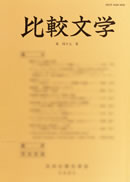Volume 64
Displaying 1-26 of 26 articles from this issue
- |<
- <
- 1
- >
- >|
ARTICLES
-
2022 Volume 64 Pages 9-22
Published: March 31, 2022
Released on J-STAGE: April 01, 2023
Download PDF (367K) -
2022 Volume 64 Pages 23-36
Published: March 31, 2022
Released on J-STAGE: April 01, 2023
Download PDF (304K) -
2022 Volume 64 Pages 37-50
Published: March 31, 2022
Released on J-STAGE: April 01, 2023
Download PDF (364K) -
2022 Volume 64 Pages 51-64
Published: March 31, 2022
Released on J-STAGE: April 01, 2023
Download PDF (315K) -
2022 Volume 64 Pages 65-79
Published: March 31, 2022
Released on J-STAGE: April 01, 2023
Download PDF (405K)
-
2022 Volume 64 Pages 80-83
Published: March 31, 2022
Released on J-STAGE: April 01, 2023
Download PDF (146K)
-
2022 Volume 64 Pages 84-87
Published: March 31, 2022
Released on J-STAGE: April 01, 2023
Download PDF (128K) -
2022 Volume 64 Pages 88-91
Published: March 31, 2022
Released on J-STAGE: April 01, 2023
Download PDF (152K) -
2022 Volume 64 Pages 92-95
Published: March 31, 2022
Released on J-STAGE: April 01, 2023
Download PDF (160K) -
2022 Volume 64 Pages 96-99
Published: March 31, 2022
Released on J-STAGE: April 01, 2023
Download PDF (178K) -
2022 Volume 64 Pages 100-103
Published: March 31, 2022
Released on J-STAGE: April 01, 2023
Download PDF (153K) -
2022 Volume 64 Pages 104-108
Published: March 31, 2022
Released on J-STAGE: April 01, 2023
Download PDF (210K) -
2022 Volume 64 Pages 109-112
Published: March 31, 2022
Released on J-STAGE: April 01, 2023
Download PDF (183K) -
2022 Volume 64 Pages 113-116
Published: March 31, 2022
Released on J-STAGE: April 01, 2023
Download PDF (262K) -
2022 Volume 64 Pages 117-121
Published: March 31, 2022
Released on J-STAGE: April 01, 2023
Download PDF (213K) -
2022 Volume 64 Pages 122-125
Published: March 31, 2022
Released on J-STAGE: April 01, 2023
Download PDF (183K) -
2022 Volume 64 Pages 126-129
Published: March 31, 2022
Released on J-STAGE: April 01, 2023
Download PDF (152K) -
2022 Volume 64 Pages 130-134
Published: March 31, 2022
Released on J-STAGE: April 01, 2023
Download PDF (186K) -
2022 Volume 64 Pages 135-138
Published: March 31, 2022
Released on J-STAGE: April 01, 2023
Download PDF (182K) -
2022 Volume 64 Pages 139-144
Published: March 31, 2022
Released on J-STAGE: April 01, 2023
Download PDF (256K) -
2022 Volume 64 Pages 145-148
Published: March 31, 2022
Released on J-STAGE: April 01, 2023
Download PDF (211K) -
2022 Volume 64 Pages 149-153
Published: March 31, 2022
Released on J-STAGE: April 01, 2023
Download PDF (168K) -
2022 Volume 64 Pages 154-157
Published: March 31, 2022
Released on J-STAGE: April 01, 2023
Download PDF (169K) -
2022 Volume 64 Pages 158-161
Published: March 31, 2022
Released on J-STAGE: April 01, 2023
Download PDF (178K)
-
2022 Volume 64 Pages 247-241
Published: March 31, 2022
Released on J-STAGE: April 01, 2023
Download PDF (315K)
SYNOPSES
-
2022 Volume 64 Pages 252-248
Published: March 31, 2022
Released on J-STAGE: April 01, 2023
Download PDF (298K)
- |<
- <
- 1
- >
- >|
